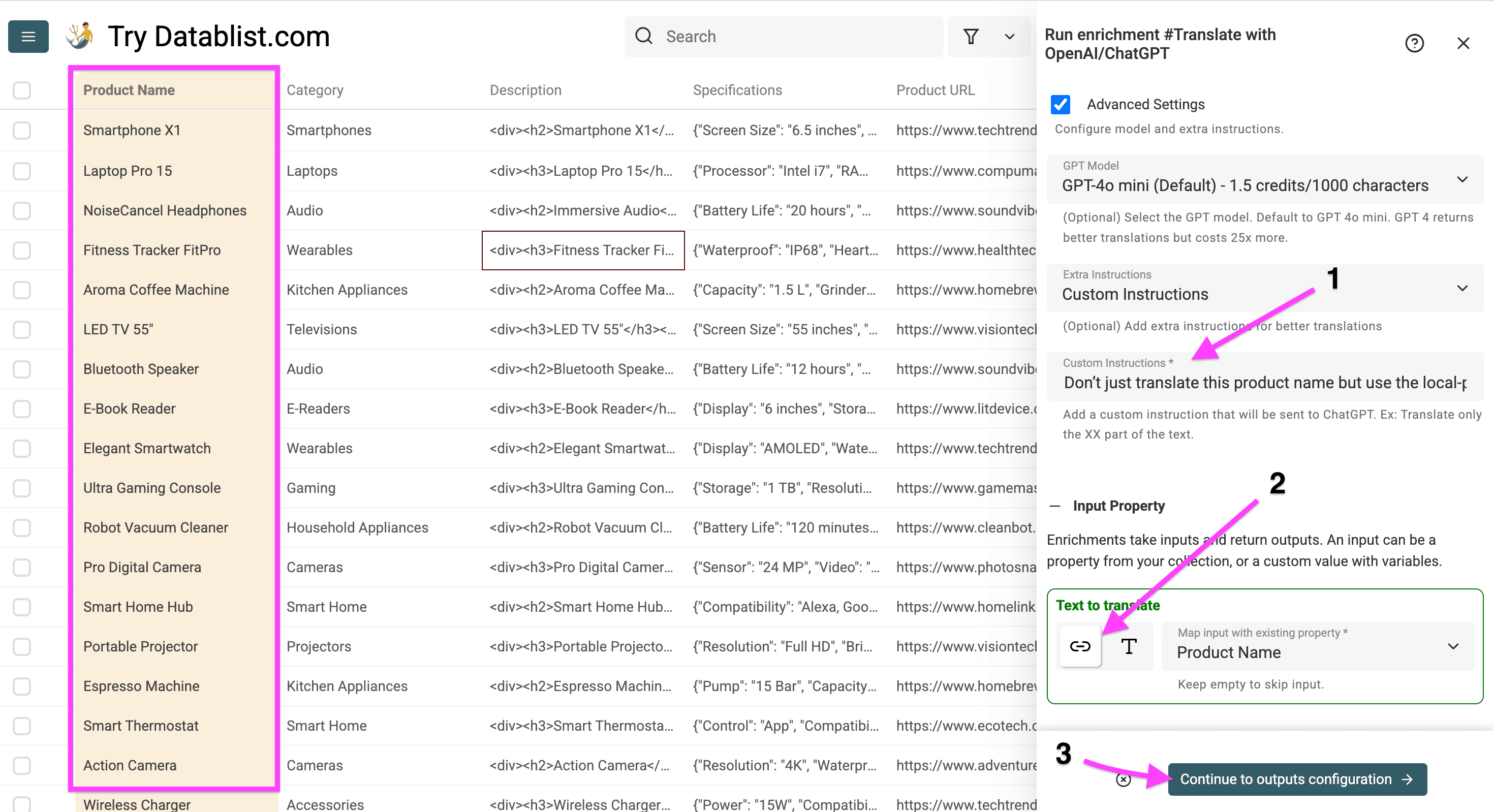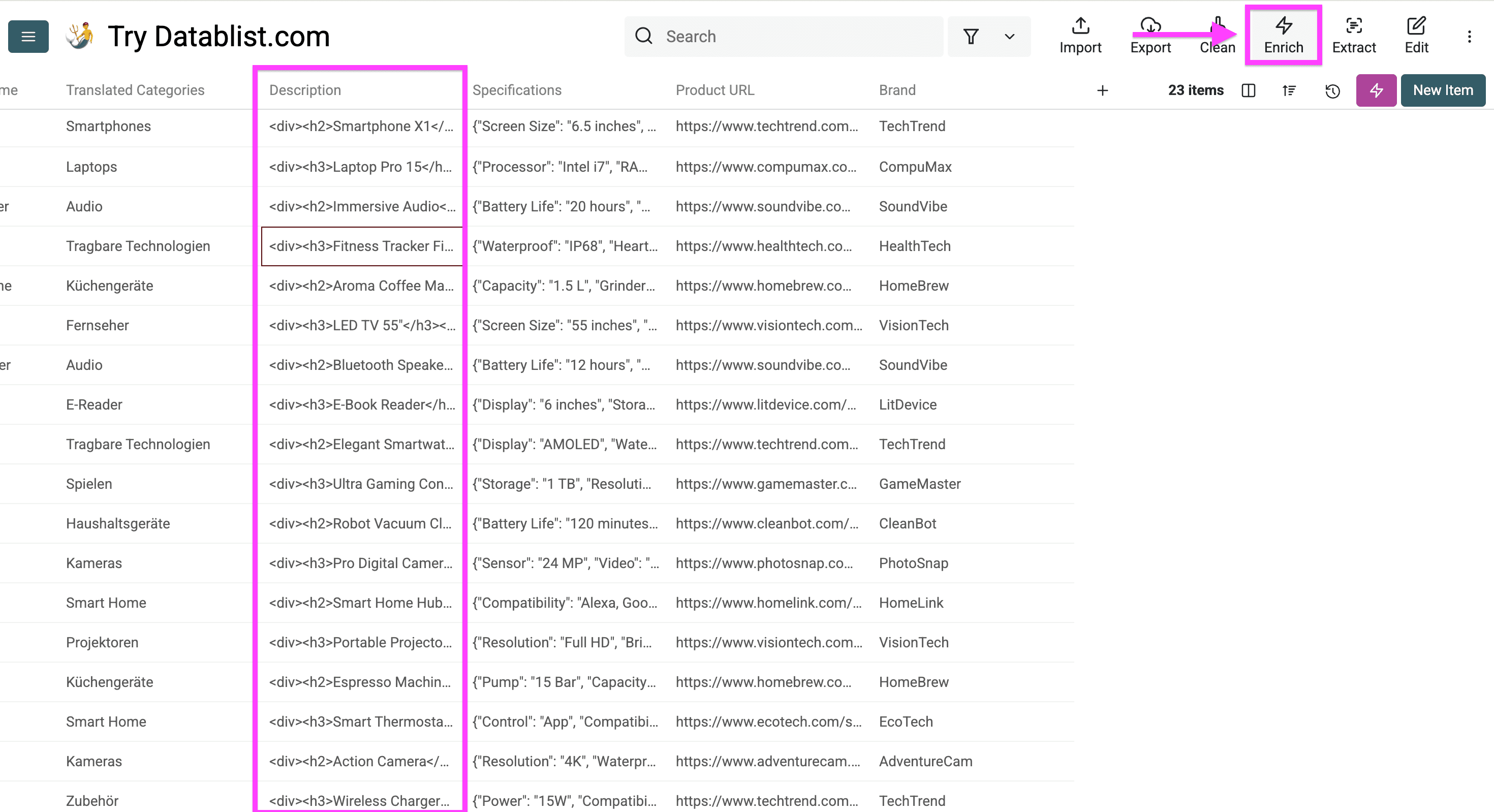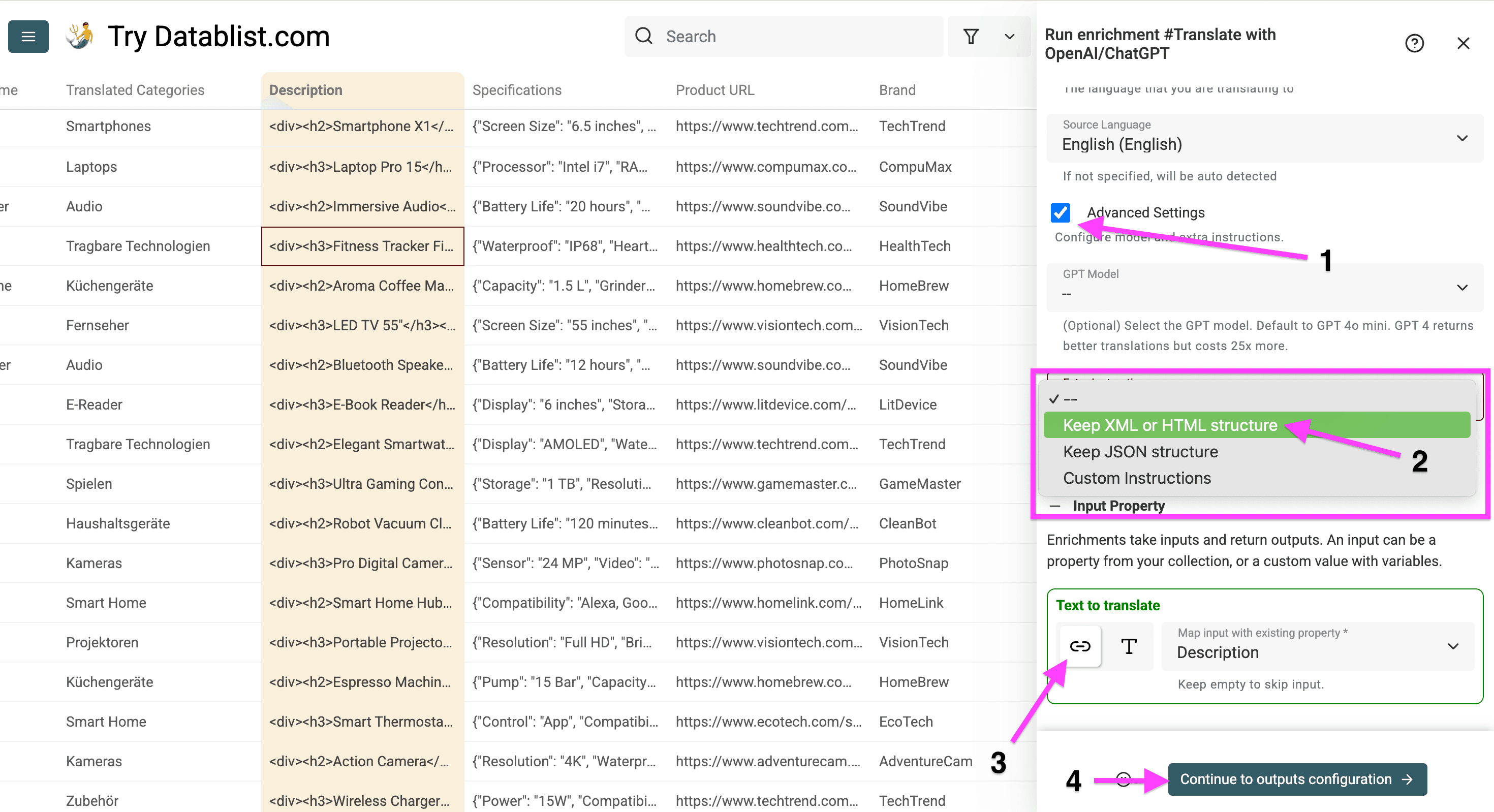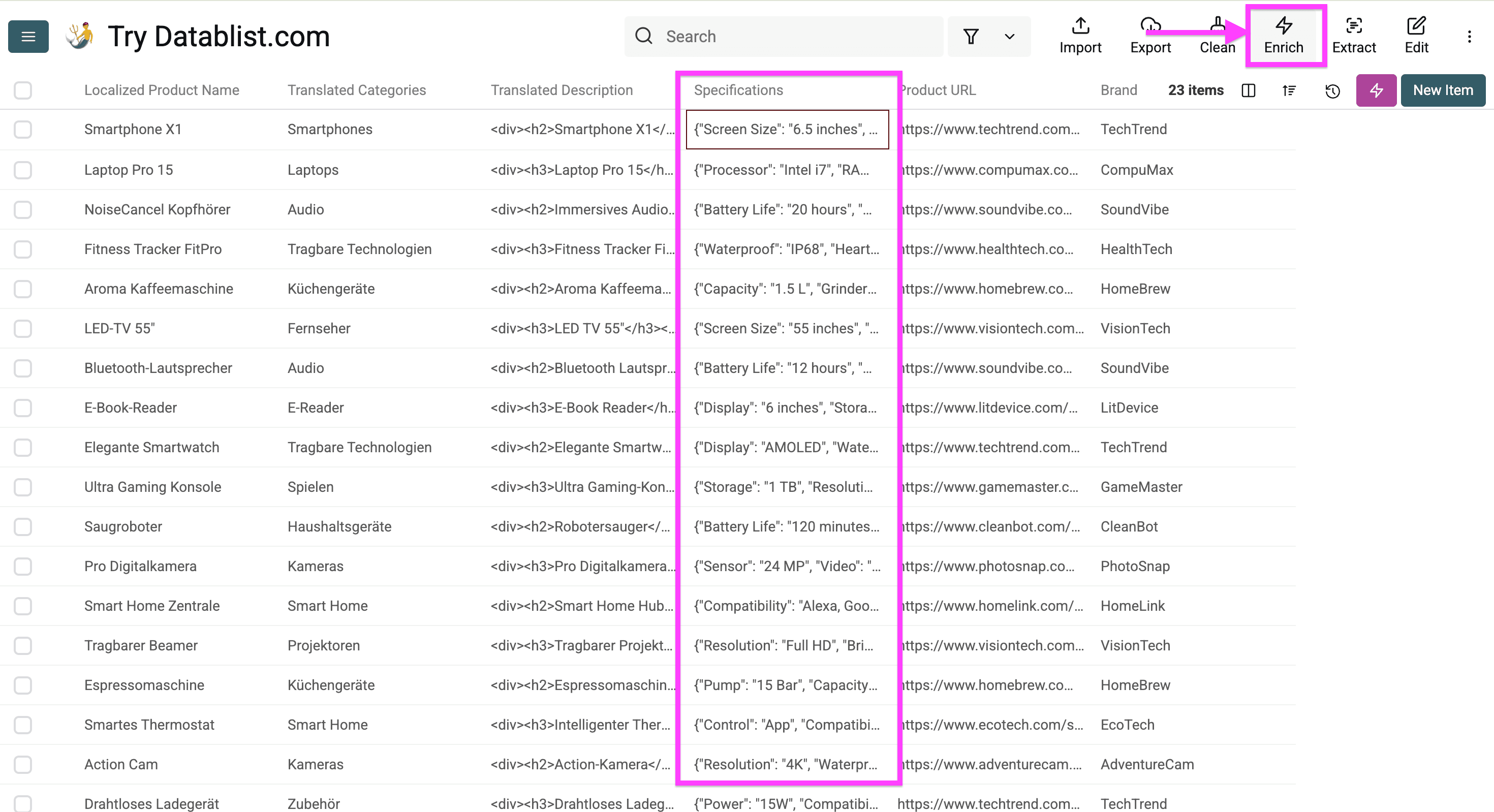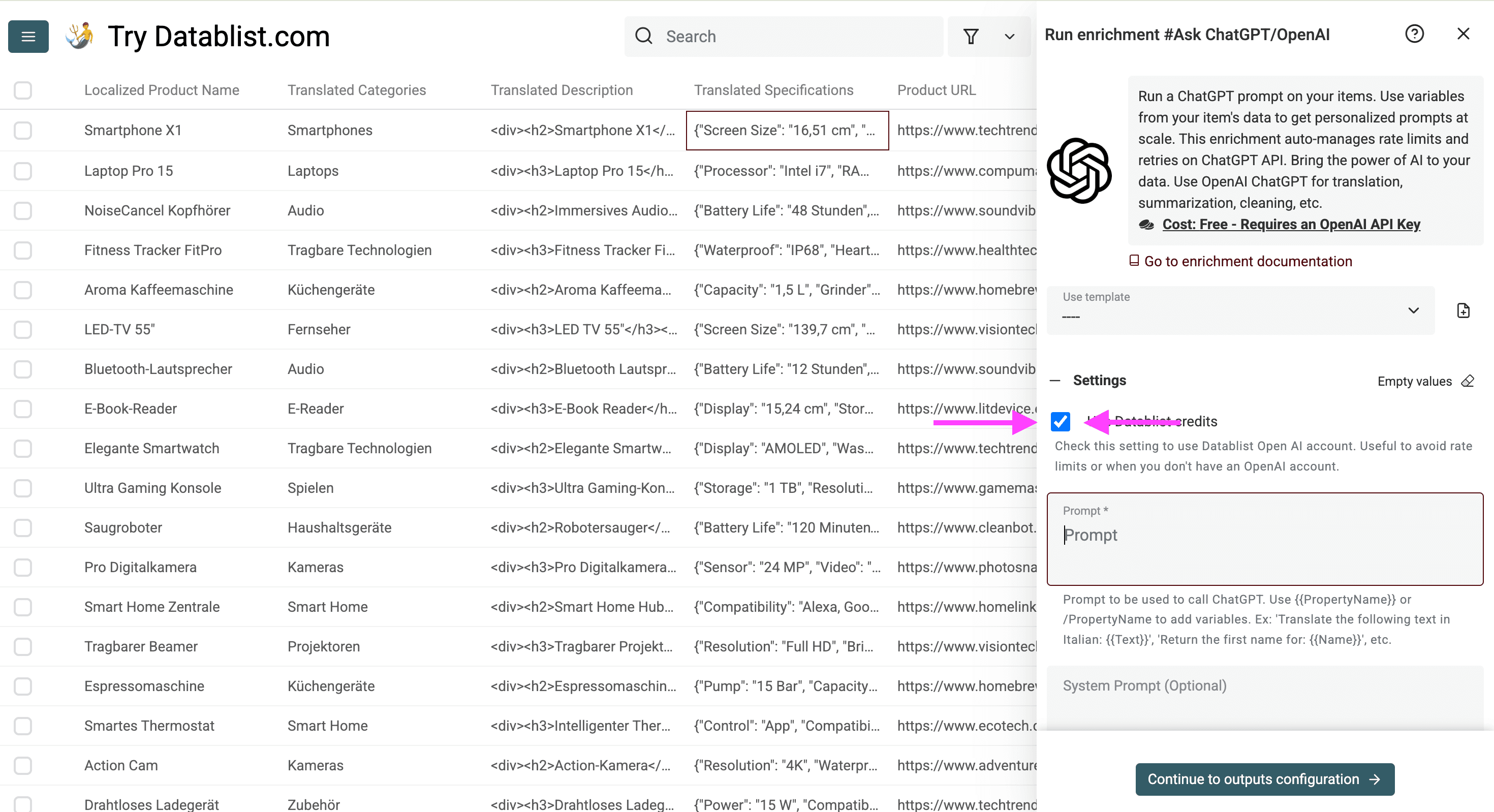Selling your products to multiple audiences is the key to growing your revenue on your eshop.
But e-commerce platforms don't make it easy for you to translate your content to multiple languages.
For example, the "Translate and Adapt" tool from Shopify isn't built for accuracy, nor is it built for scale and international SEO.
Since you still need to translate your e-commerce product catalog to be successful in international markets, I'll show you today how to translate your e-commerce inventory with AI and avoid losing HTML, XML, or JSON structures.
What You Will Learn in This Guide:
- How to localize product names
- How to translate product categories
- How to keep HTML tags while translating
- How to adapt product specifications in json to local units
- How to add subdirectories to URLs automatically
- Why you should use AI for translations
Step 1 – Requirements for Translating a Product Catalog
Let's talk first about what you'll need to translate your product catalog:
- A CSV or Excel file containing the products. Check the export options in your e-commerce platform. Shopify, BigCommerce, WooCommerce, Magento, PrestaShop, etc. have tools to get export and reimport CSV with edits. It also works for translating product catalog to sell on international marketplaces (Amazon, Etsy, Rakuten, AliExpress, MercadoLibre, Lazada, etc.)
- An AI assistant that can run on each row and handle high volume.
In this guide we’ll:
- Translate a catalog from English to German as an example
- Use the ChatGPT translator from Datablist
📘 What is Datablist?
Datablist is an AI-Powered Spreadsheet allowing you to clean, enrich and manage your lists and automate workflow such as translations of CSV files.
Step 2 - Importing the CSV
Once you have your catalog in CSV/Excel format, sign up for Datablist.
And import the CSV with your product catalog.
This sample file contains a wide variety of products with specific format.
I'll use to showcase how I translate:
- product names
- product categories
- product descriptions containing HTML tags.
- product specifications in JSON format
And modify product links (URLs) with 100% accuracy.
Step 3 - Localizing Product Names
One significant limitation of translators like Google Translate (which Shopify's "Translate and Adapt" runs on) is their inability to adapt to natural language.
That's why I am not using the phrase "translating product names" but "localizing product names", because direct translations are often too formal and don't match the terms that local customers actually use.
To do so, you have first to click on "Enrich".
Then go to “Translations” and select “Translate with OpenAI/ChatGPT”
Once you open this enrichment, you'll be able to define:
-
The language your product catalog should be translated to
-
The default language of your product catalog (this is optional and can also be auto-detected)
The source and target language of my product names -
The ChatGPT model you want to use to translate.
-
Custom instructions on how to deal with your data, which includes:
- Keeping HTML and/or XML structures
- Keeping JSON formats
- Adding custom instructions (what we'll do)
-
The column that should be translated.
Now we'll instruct the AI to use authentic, locally-preferred terms and vary them appropriately.
Here are the instructions I used:
Don't just translate this product name but use the locally-preferred term for it and keep English terms that Germans would also use in their everyday life.
Click then on "Continue to output configuration" to configure our output fields where your localized product name will be inserted in.
Click on the plus icon to create a new column, and then click on "Instant Run" to start localizing your product names.
The results are really impressive (German readers will know).
💡 Interesting Fact
A Springer research shows that 55% of consumers buy only a product if it's in their local language, with 52.4% even prioritizing language over price.
Step 4 - Translating Product Categories with AI
Here, we will go through the same process as shown in the example before — the only difference is that we won't use any custom instructions to match local expressions, since product categories are always written in formal language.
Click on "Enrich".
Select “Translations” and open “Translate with OpenAI/ChatGPT”
Configure your source language, target language, and the column you want to translate, then click on "Continue to output configuration"
Click now on the plus to create a new column and then on "Instant Run" to start translating your product categories to a different language.
Here are our accurately translated results again
Now that we have the basic translations done, let's move on to translating product descriptions without translating the HTML tags.
Step 5 - Translating Product Descriptions without Breaking the HTML
Translating product descriptions without translating the HTML tags is not as easy as it sounds, but thankfully we added pre-defined custom instructions to our AI assistant, so it knows exactly how to deal with the HTML tags.
You can start by clicking on “Enrich”.
Select “Translations” and open “Translate with OpenAI/ChatGPT”
Once the enrichment opens, configure your source and target language.
To translate the product description without translating the HTML tags:
- First, check the box to the left of "Advanced Settings" and open "Extra Instructions"
- Second, select "Keep XML or HTML structure"
- Third, map the column where your product description is to the AI translator.
Then click on "Continue to outputs configuration".
Now, create a new column to store the translated product descriptions in by clicking on the plus, and finally click on "Instant Run" to start translating.
This is how my translated description looks, and as you can see, the HTML tags haven't been translated or affected in any other form.
Now that we're done with translating the HTML description of our product catalog, we can move on to the product specifications, which are in a JSON format that also needs to be maintained.
With that being said, let's go!
Step 6 - Translating Product Specifications While Maintaining JSON Format
To start translating the JSON format, click on "Enrich".
When translating product specifications in JSON format, maintaining the structure is crucial for multiple reasons:
- JSON is a structured data format where both keys and values have specific roles/
- Traditional translators often break the JSON structure by translating keys that should remain untouched.
- Invalid JSON can cause technical issues when importing back to your e-commerce platform.
Select "Translations" and open "Translate with ChatGPT/OpenAI".
Configure your source and target languages.
Now, select "Custom Instructions" in the advanced settings and paste this in the field under it: Keep JSON format without translating the keys. Convert measurements from imperial units (inches, feet, pounds etc.) to metric units. The only output I want is the translated values, nothing more.
Then select the "Specifications" column and click on "Continue to output configuration".
These settings ensure that:
- Local customers can understand specifications more easily (as we’re translating to German)
- Only the values within the JSON are translated
- JSON keys remain in their original form
- The JSON structure stays intact and valid
For example, if you have a JSON specification like this:
{
"dimensions": {
"length": "20 inches",
"width": "15 inches",
"height": "10 inches"
},
"material": "genuine leather"
}
Other translators often create two major problems:
- They incorrectly translate JSON keys like "dimensions" and "material" that should remain untouched
- They keep measurements in non-local units, making it hard for customers to understand specifications
These issues can:
- Break your JSON structure
- Make product details confusing for local customers
- Result in fewer orders
Our AI assistant solves this by only converting and translating the units and values while keeping the structure intact, resulting in:
{
"dimensions": {
"length": "50,8 Zentimeter",
"width": "38,1 Zentimeter",
"height": "25,4 Zentimeter"
},
"material": "echtes Leder"
}
Now, create a new column for your translated specifications by clicking on the plus, and then click on "Instant Run" to begin the translation process while maintaining your JSON format.
This is how your translated specifications look:
Now that we have translated the product names, categories, product descriptions, and specifications, the only thing we need to do is add a subdirectory to the product URL.
Step 7 - Adding a Subdirectory to Your URL
This step is also pretty easy and straightforward. Begin by clicking on "Enrich."
Now we will not choose "Translations" but select "AI" and open "Ask OpenAI/ChatGPT"
Once you've opened it, make sure to check the highlighted box to use Datablist's provided API key for this task. For instructions on setting up your own OpenAI account and API key, click here.
Paste the prompt below into Datablist to add a "/de" subdirectory to all URLs while maintaining their original structure, and click on "Continue to outputs configuration"
Here's the prompt I used:
Context: I need to add a German language subdirectory to product URLs without changing their existing structure
=====
What I want you to do: Insert "/de" at the beginning of each URL path while preserving the rest of the URL
=====
How to do it: Add the "/de" subdirectory right after the domain name but before the existing path
=====
Important mention about the task: Do not modify any other parts of the URL structure; only add the language subdirectory
=====
Example input: domain.com/products/category/item-1
Example output: domain.com/de/products/category/item-1
=====
When using this prompt, make sure you use "/" or "{{}}" to refer to a column in your catalog. If you want to learn how to write prompts like the one above, check our guide
Now click on the plus to create a new column and then on "Instant Run" to start adding subdirectories to your product URLs
After running it, you'll get results like these:
And this is how it looks like when the entire product catalog is translated:
Why You Should Always Translate with AI
Let's review what we've accomplished in this guide:
- Product Names: Localized product titles while maintaining brand names and model numbers
- Categories and Navigation: Translated category names
- Product Descriptions with HTML: Translated while keeping HTML tags using Datablist's translation feature with specific instructions for maintaining markup
- Product Specifications in JSON: Successfully translated values while maintaining JSON structure intact and converting measurements to metric units to avoid confusing local buyers
- URL Structure: Added language subdirectories ("/de") to product URLs without breaking their structure using custom AI prompts
Benefits of this approach:
- Your customers find your product more easily
- Your product catalog is now technically perfect with intact HTML and JSON formatting
- All your data structures remain clean and functional
- Your customers see measurements in their familiar metric units
- Your store ranks better in local search results with language-specific URLs
This process ensures that your translated catalog is not only linguistically accurate but also technically sound and ready for deployment to your e-commerce platform.
Frequently Asked Questions
How do I translate my online store to other languages?
The most effective way is to use specialized e-commerce translation tools or platforms that support multi-language capabilities. You'll need to translate product descriptions, categories, pricing, checkout processes, and ensure proper URL structure for each language.
Which is better for store translation: manual or automatic translation?
Both methods have their place. Automatic translation is faster and more cost-effective for large catalogs, but may need human review for accuracy. Manual translation provides higher quality but is more time-consuming and expensive. A hybrid approach often works best, using automatic translation with human review for critical content.
How much does it cost to translate an e-commerce website?
Translation costs vary based on your catalog size and language pairs. Professional translation services typically charge $0.10-0.25 per word. Automated solutions like translation platforms offer subscription models ranging from $29-499 per month depending on word count and features needed.
Will translating my online store affect my SEO?
When done correctly, translating your store can significantly improve your SEO by targeting local search queries. Key factors include proper URL structure (using language subdirectories or subdomains), translated meta tags, and localized keywords. You'll also need to implement hreflang tags to help search engines understand your site's language versions.
How do I maintain product data consistency across multiple languages?
Use a centralized product information management (PIM) system to maintain your master catalog. This ensures all translations stay synchronized with your original content and helps manage updates across all language versions. Keep a glossary of important terms and their approved translations for consistency.
What are common mistakes when translating an e-commerce site?
Common pitfalls include not localizing measurements and currencies, ignoring cultural preferences, breaking technical formats like HTML or JSON, forgetting to translate navigation elements and error messages, and not implementing proper URL structures for different languages.
What are the best alternatives to Weglot for e-commerce translation?
While Weglot is popular, tools like Datablist are better suited for translating structured data such as product inventories. The best choice depends on your specific needs - Weglot works well for general website content, while Datablist excels at maintaining formats and data structures.
How do I maintain HTML and JSON formatting during translation?
Use tools like Datablist to handle structured data. These tools should preserve HTML tags and JSON structures while only translating the content within them. Always test the translation output to ensure technical formatting remains intact before implementing changes.









